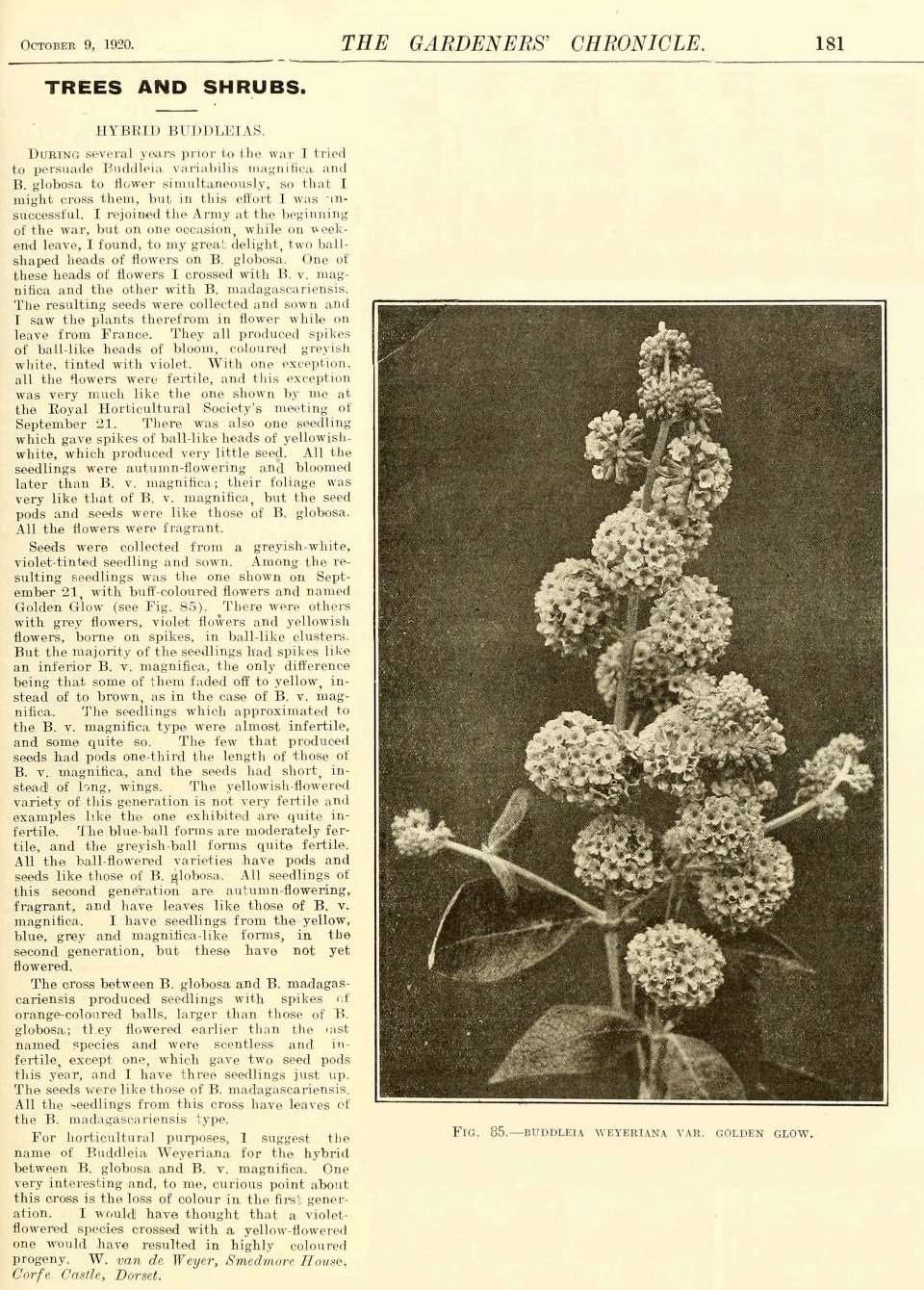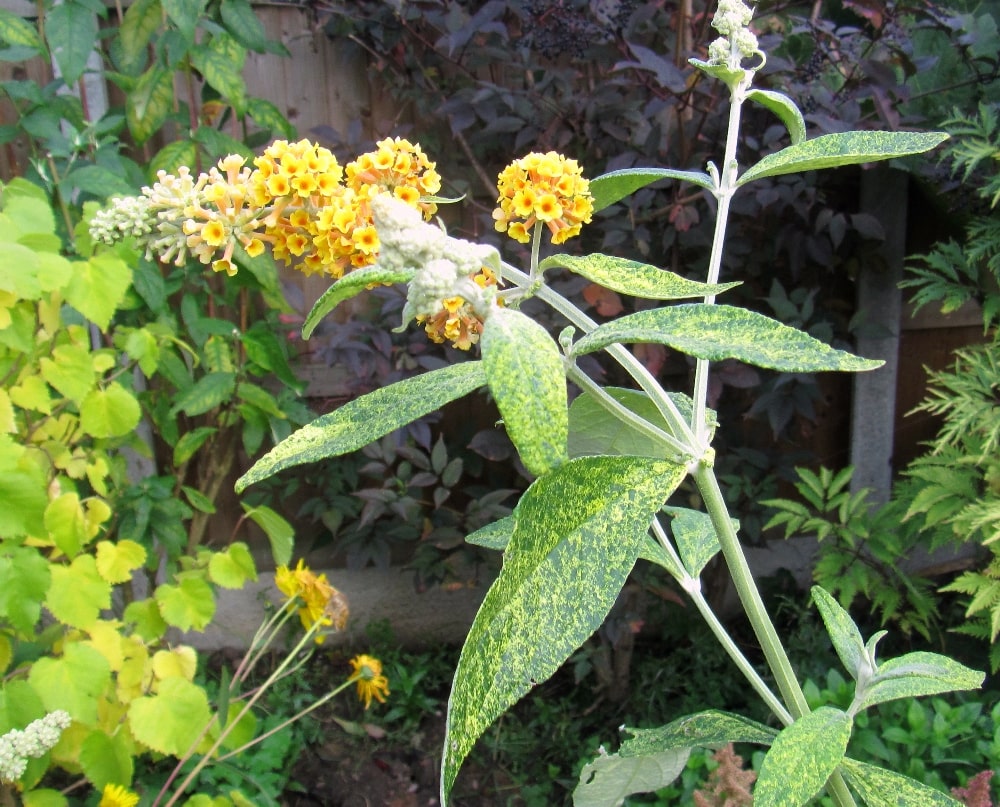
Buddleja x weyeriana
Revised April 2021
The Buddleja x weyeriana are large hybrid shrubs, notable for their yellow- or cream-coloured flowers. Their origin is well documented: during the First World War Major William van de Weyer of Smedmore House, at Corfe Castle, pollinated the South American species B. globosa with pollen from B.davidii var. magnifica, a native of China.(Weyer 1920). The 'Magnifica' variety was perhaps the best form of B.davidii at the time, predating the development of modern garden cultivars. Van de Weyer was perhaps fortunate, as the flowering of the two species only rarely coincides, and the more so that it occurred while he was on leave from the Army.
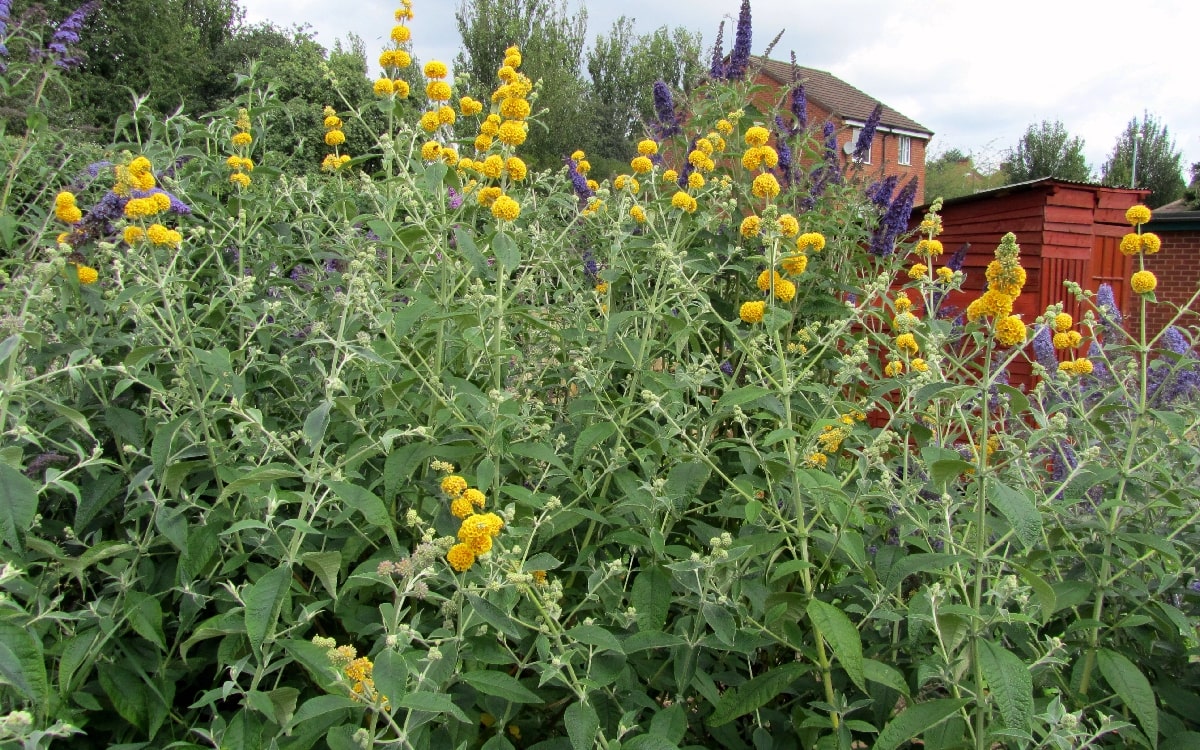
B. x weyeriana 'Sungold' and 'Honeycomb' with their bright yellow flowers.
Open full size image in a new window.
The resulting F1 (first generation) progeny were a disappointment: poor colours, mostly greyish white with a violet flush. He then interbred the F1 generation, taking seed from a single plant. He met with more success in the F2 (secind generation) plants, giving the world the yellow flowered 'Golden Glow'.
'Moonlight', a B. x weyeriana with lilac-flushed pale flowers, must also have come from this F2 generation, but van de Weyer doesn't mention it specifically. They share many features: the form and the foliage generally resemble B. davidii, and they'll grow into similar large messy shrubs left unpruned. The inflorescences are intermediate, consisting of a number of loose balls. The flowers have the typical orange eye of Asian Buddleja species, but the yellow outer corolla of 'Golden Glow' is inherited from B. globosa.
'Golden Glow' and 'Moonlight' are the two original cultivars, and it would seem van de Weyer's hybridisation has never been successfully repeated, with a later cultivars being sports rather than genetically unique seedlings. 'Sungold' is a sport (not a seedling) of 'Golden Glow' raised in the 1960s in the Netherlands, which has no lilac flush and is a good clear yellow (de Vogel 1967 - Dendroflora 4:61).
'Variegata', possibly the variegated form once listed by the RHS as 'Flight's Fancy', is a sport of 'Sungold'; the leaves are splotched with yellow rather than having defined pale margins. 'Honeycomb', whose history is well documented, represents a superior clone of 'Sungold', and is claimed to be a little brighter.
The origin and authenticity of many of the other named cultivars is a matter of some controversy. Several other yellow-flowered cultivars have been listed, and none of these can be verified as genuinely separate cultivars. 'Elstead Hybrid', 'Lady de Ramsey', 'Golden Tassels', 'Watson's Gold', 'Orange Glow' and 'Trewithen' have been published in catalogues and accepted by the RHS as authentic names. Several of these arcane cultivars were sent for evaluation at the Longstock Nursery and they all proved to be either 'Golden Glow' or 'Sungold'. Likewise 'Beech Park', 'Liberty' and 'Hocus Pocus' are erroneous synonyms for van de Weyer's original 'Moonlight'.
There appears to be two clones of 'Moonlight'. The most common one, and this is probably the original plant of van de Weyer, has very soft flowers, which are a creamy white with a lilac-lavender flush, particularly in bud, and a large orange eye. The Lavender Garden National Collection has a second rather different version. Rather than creamy white, the predominant colour is a biscuit-yellow, and is hereafter called 'Moonlight Biscuit' to distinguish it from the original plant, whcih we'll call 'Moonlight Pale' for convenience.
The origin of 'Moonlight Biscuit' is unknown and I think it's a sport; most probably it came out of 'Golden Glow', which is prone to throwing sports; I've seen its flowers occasionally resemble 'Moonlight Biscuit'. I can't discount the possibility 'Moonlight Biscuit' is one of the many 'lost' cultivars of B. x weyeriana, but it's now impossible to say which one.
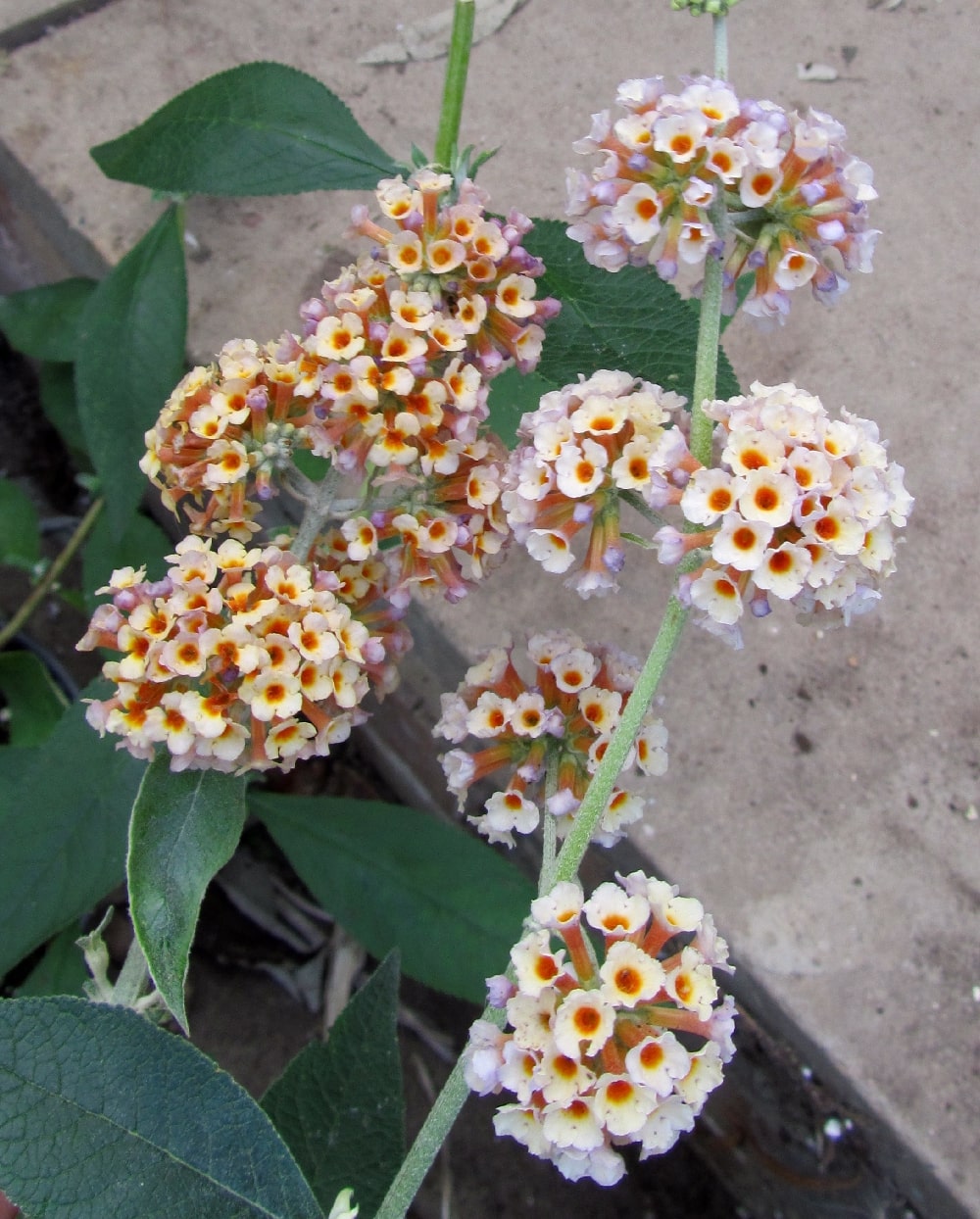
Two different B. x weyeriana 'Moonlight' plants, the one on the left is 'Moonlight Biscuit' and appears more yellow.
Open full size image in a new window.
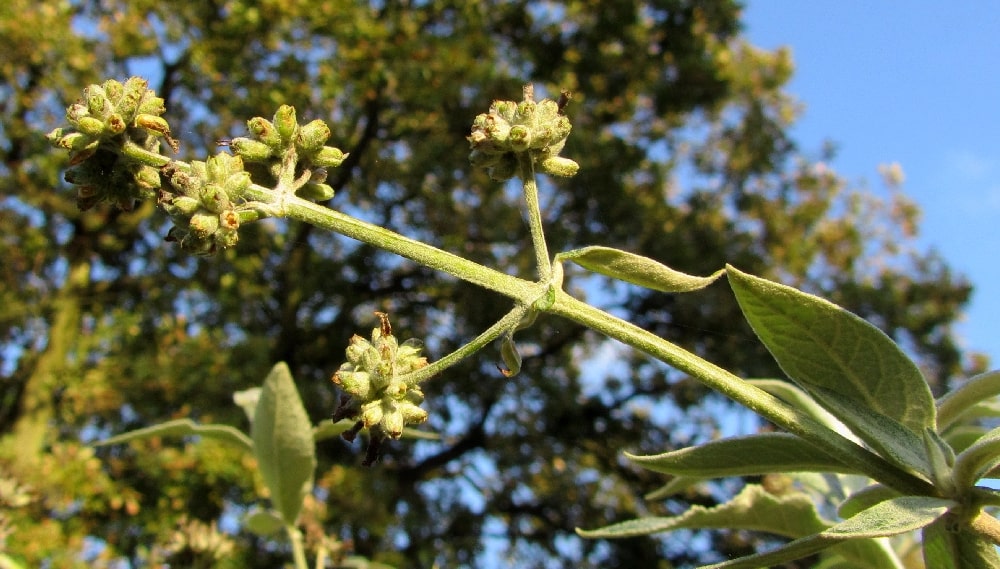
B. x weyeriana seed capsules on 'Moonlight Biscuit', which contain viable seed.
Open full size image in a new window.
Buddleja x weyeriana cultivars can produce fertile seed, although it seems likely they do not produce viable pollen.The seeds capsules are about 4-5mm long are somewhat intermediate between the parents, and smaller than those of B. globosa capsules. They take longer to mature compared to B. davidii. The proportion of fertilised seed-heads on B. x weyeriana plants depends on the availability of suitable pollen, and I've found not all B. davidii cultivars produce compatible pollen. Isolated plants may therefore appear sterile, whereas those in collections will appear quite fertile.
All Buddlejas have tiny, tiny seeds. Those of B. davidii, extreme left in the diagram, have double wings. B. globosa seeds (centre) are wingless, which one reason why this species is less invasive as its seeds are much less mobile. When I cleaned up seed from 'Honeycomb', I found that the seeds (right) are variable in shape and difficult to discern from the abundant chaff. I was able to identify a very few seeds, which have only small wings. The seeds (excluding the wings) are much smaller than those of B. globosa, the grain slightly smaller than those of B. davidii, and are unlike both ancestors. I have found the seeds, if the capsules are fully formed, to be mostly viable.

Comparson of the seeds of B. x weyeriana with those of its ancestors.
I have collected and grown seeds from several of the B. x weyeriana cultivars. In general, the seedlings resemble B. davidii quite closely; often the inflorescence is somewhat distinctive in form, having a number of loose balls running up the panicle. The colours of the flowers in the seedlings are very varied and presumbly dependent mostly on the pollen parent; for example, I have used B. davidii 'Darent Valley' as the pollinator and the offspring have been pure-white flowered. The flowers can be mauve, purple, blue or pink; some have flowers in delicate pastel shades.
Occasionally they may be varicoloured, such as the one shown with delicate shades of lavender and peach, where the main colour is weak and underscored by a yellowish pigment. None has ever come out pure yellow. Most are seed sterile; even where they form seed capsules, these have no viable seed or very low viability. I haven't investigated whether they produce viable pollen.
A number of commercially available cultivars are hybrids derived from B. x weyeriana, and several are described below. They have been bred on both sides of the Atlantic and often have the advantage of seed sterility, a requirement for cultivars sold in regions were B. davidii has been declared an invasive weed. One worth mentioning is Buddleja 'Attraction', a deep pink-purple hybrid from an open pollination of 'Honeycomb' (selected by Mike Dirr, Univeristy of Georgia). This proved to be pollen fertile and has been used in a number of further hybridisations, including developing Buddleja 'Miss Ruby' ('White Ball' X 'Attraction').
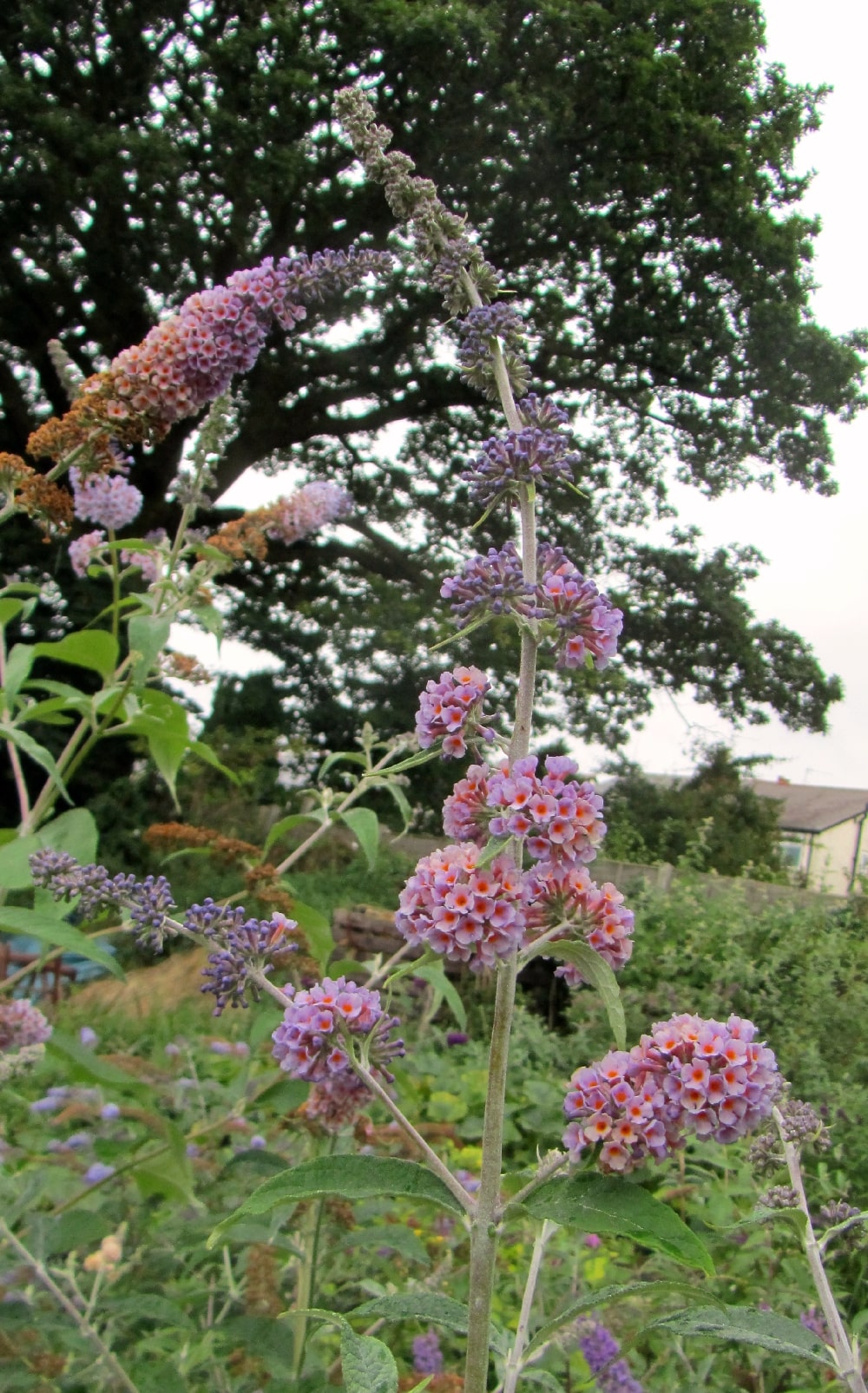
A particularly nice B. x weyeriana seedling with varicoloured flowers I'm calling 'Lavender Shades'.
Open full size image in a new window.
The Cultivars
B. x weyeriana
Golden Glow
'Golden Glow' was the first cultivar, exhibited and published by van de Weyer in 1920. The flowers are a deep yellow, although the lilac flush persisting from the buds means it's not as bright as 'Sungold'. I've found it less vigorous than the sports it gave rise to.
Open full size image in a new window.
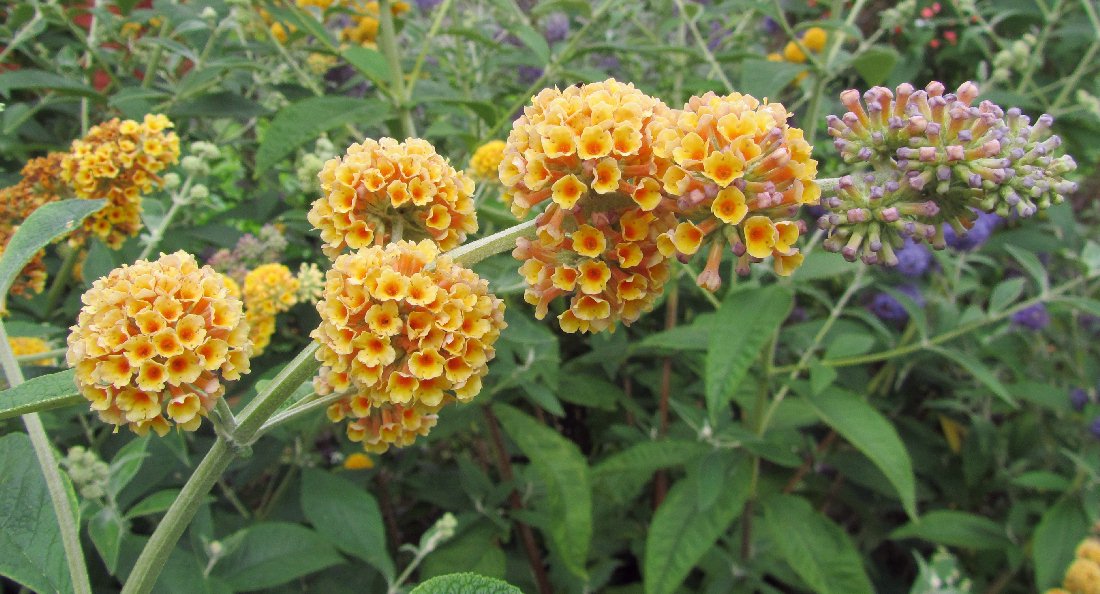
Moonlight Pale
'Moonlight' is also presumably from van de Weyer's original F2 generation. Noticeably different from 'Golden Glow', with softer petals and a large orange eye. The main colour is from almost white to a creamy peach, and the lilac flush also varies a little in intensity according to the conditions. The original cultivar I call 'Moonlight Pale' to distinguish it from 'Moonlight Biscuit' shown below.
Open full size image in a new window.
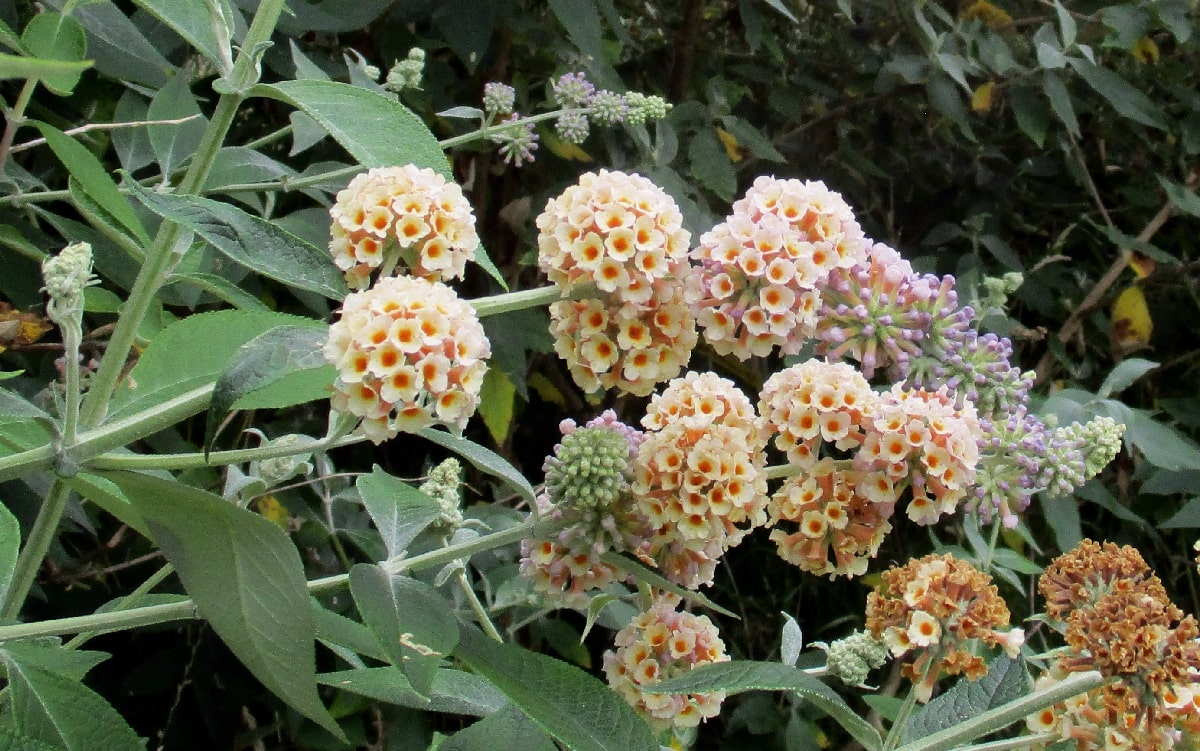
Moonlight Biscuit
'Moonlight Biscuit' is something of a mystery and its origins are unknown. On casual inspection it appears to be the same as 'Moonlight Pale', except the flowers are coloured a pale biscuit-yellow. When closely examined it becomes apparent it has probably emerged as a sport of 'Golden Glow', as the orange eye is smaller than 'Moonlight Pale' and the petals a slightly different shape; in both these respects it looks more like 'Golden Glow'.
Open full size image in a new window.
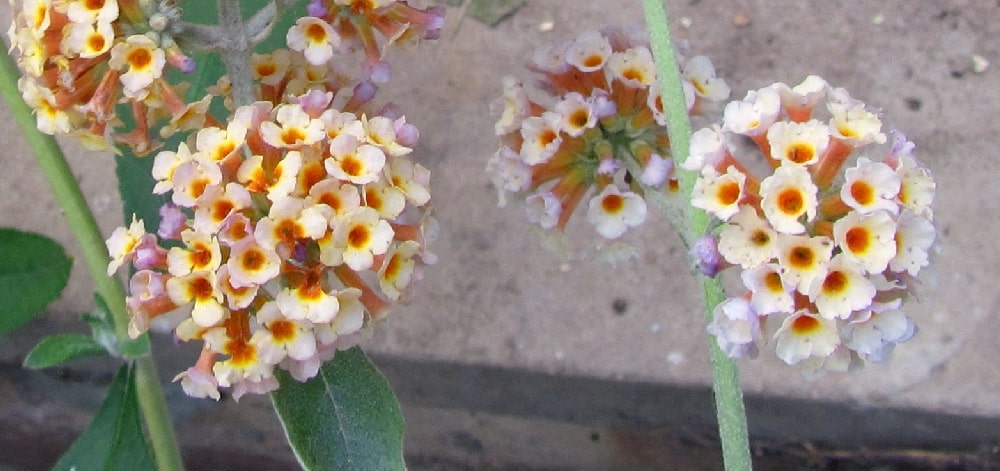
'Moonlight Biscuit' (left) is more yellow and the flowers a little different to 'Moonlight Pale' (right).
Open full size image in a new window.

Sungold
'Sungold' arose as a sport of 'Golden Glow' at the nursery of P. G. Zwijnenburg in the Netherlands in the 1960s (De Vogel, P 1967. Keuringen 1966. Dendroflora 4: 61). The lilac flush has been lost from the flowers and as a result the colour is a lot brighter. The mutation also seems to have improved the form of the flowers and made the plant a little more vigorous.
Open full size image in a new window.
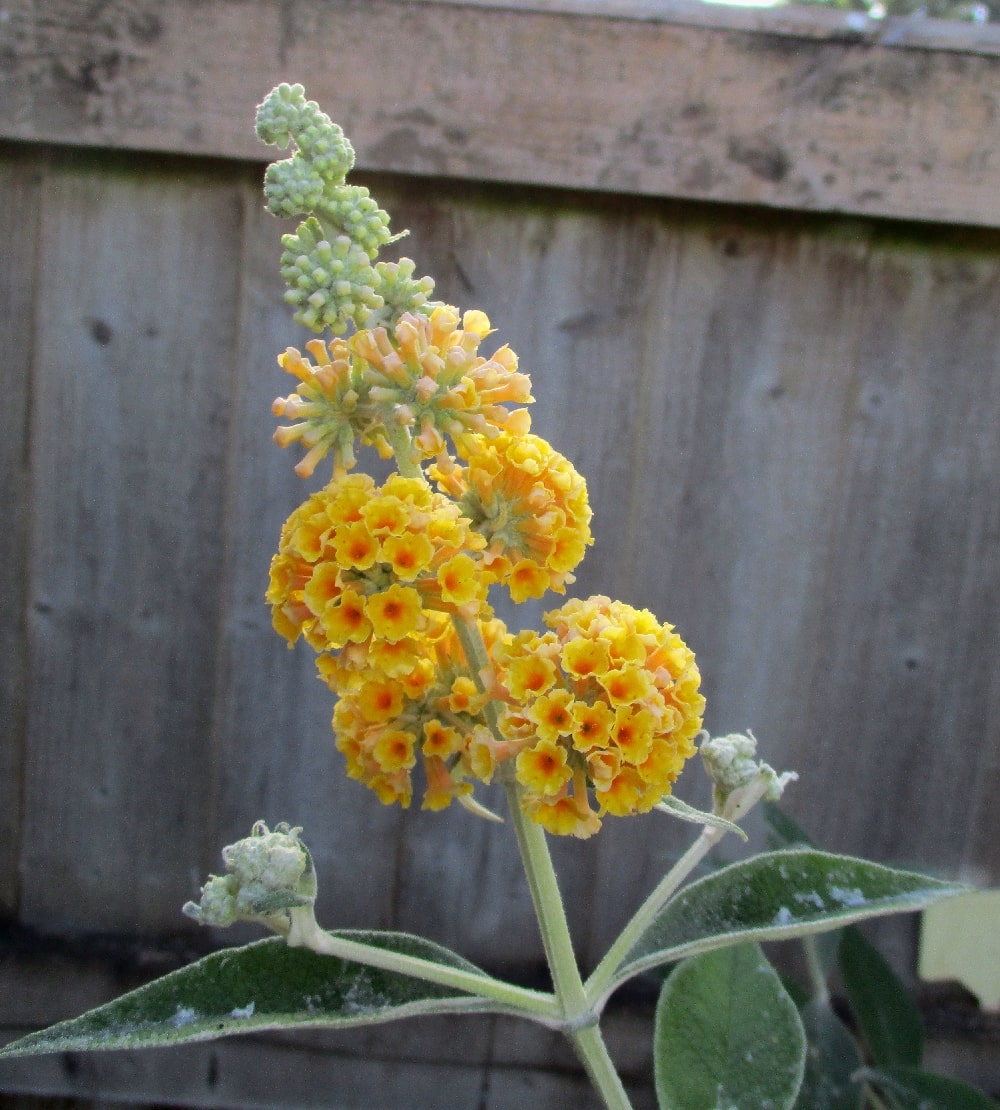
Sungold: Honeycomb
It's highly debatable whether this is actually a separate cultivar. When I assembled my collection, I obtained 'Sungold' from two sources. One turned out to be a superior form with marginally better flowers, which were bright yellow in bud, whereas the one above has a vestigial lilac-flush making the flower-buds appear grey. I realised the one with the brighter buds was probably the clone taken from Crathes Castle, Scotland to America by Mike Dirr (University of Georgia) and renamed 'Honeycomb'. To distinguish the two, I've arbitrarily labelled this better clone as 'Honeycomb'.
Open full size image in a new window.

Variegata
Yellow-spotted foliage and not the usual variegation with yellow margins, which is a rather less attractive effect and not popular. The flowers are identical to 'Sungold'. It's very prone to reversion and my plant eventually lost its variegation completely. Between its unpopularity and propensity for reversion, this cultivar is most likely dying out. This is possibly the variegated form once listed as 'Flight's Fancy'.
Open full size image in a new window.
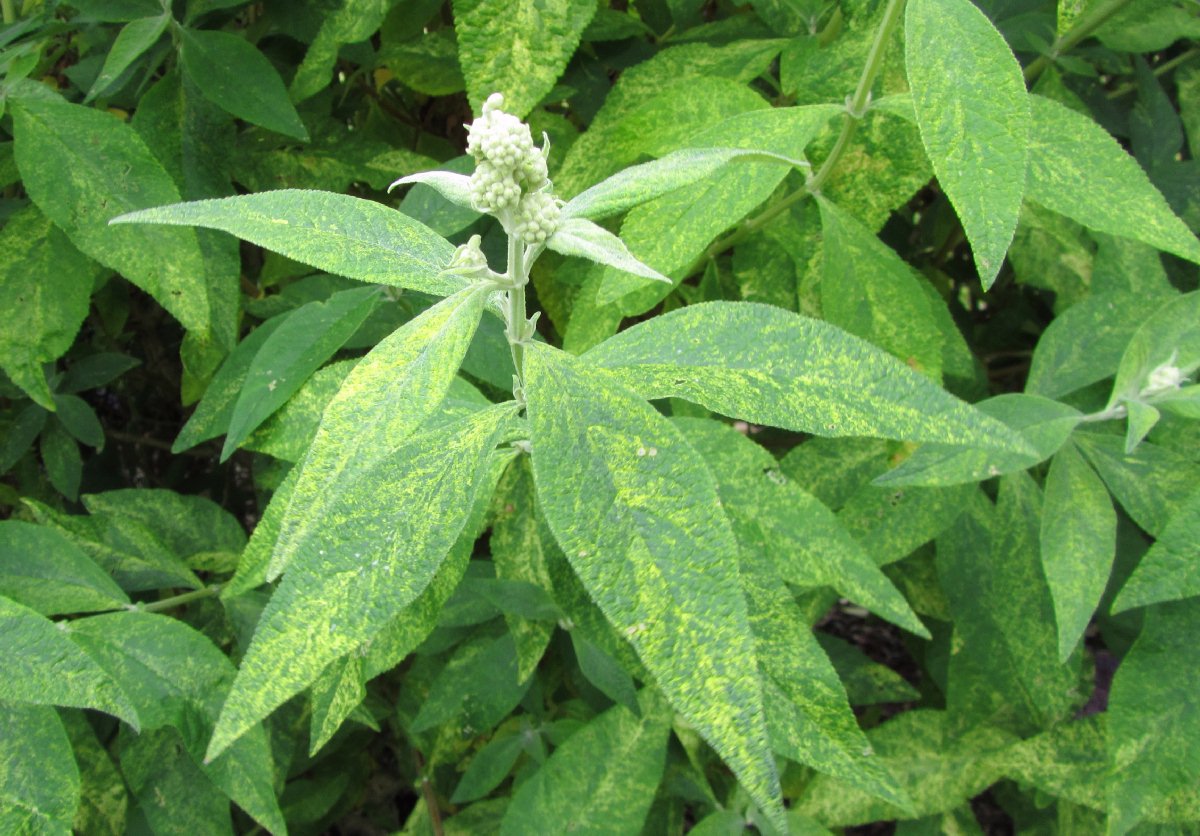
B.x weyeriana X B.davidii
Bicolor
Also marketed as Buddleja 'Flower Power' in Europe, this was a seedling of 'Honeycomb' open-pollinated with B. davidii raised by Mike Dirr (University of Georgia) in 1999; he also bred 'Attraction' around the same time.
A medium sized and vigorous shrub, 'Bicolor' performs well in the garden. The inflorescences are a reasonable size, shaped like B. davidii, and a good purply shade. As they fade, there can be a colour change to an orangey colour, described as butterscotch-orange. There are many great publicity photos of this cultivar. However, the bi-coloured effect does not always look so striking, with the flowers turning brown before the secondary colour can come through. My theory is that the orange is caused by the purple colour fading out slightly and exposing an underlying yellow pigment in the petals. Several of my own 'Honeycomb' seedlings produce a similar effect.
Seed sterile, but I've been told the pollen is viable.
Open full size image in a new window.
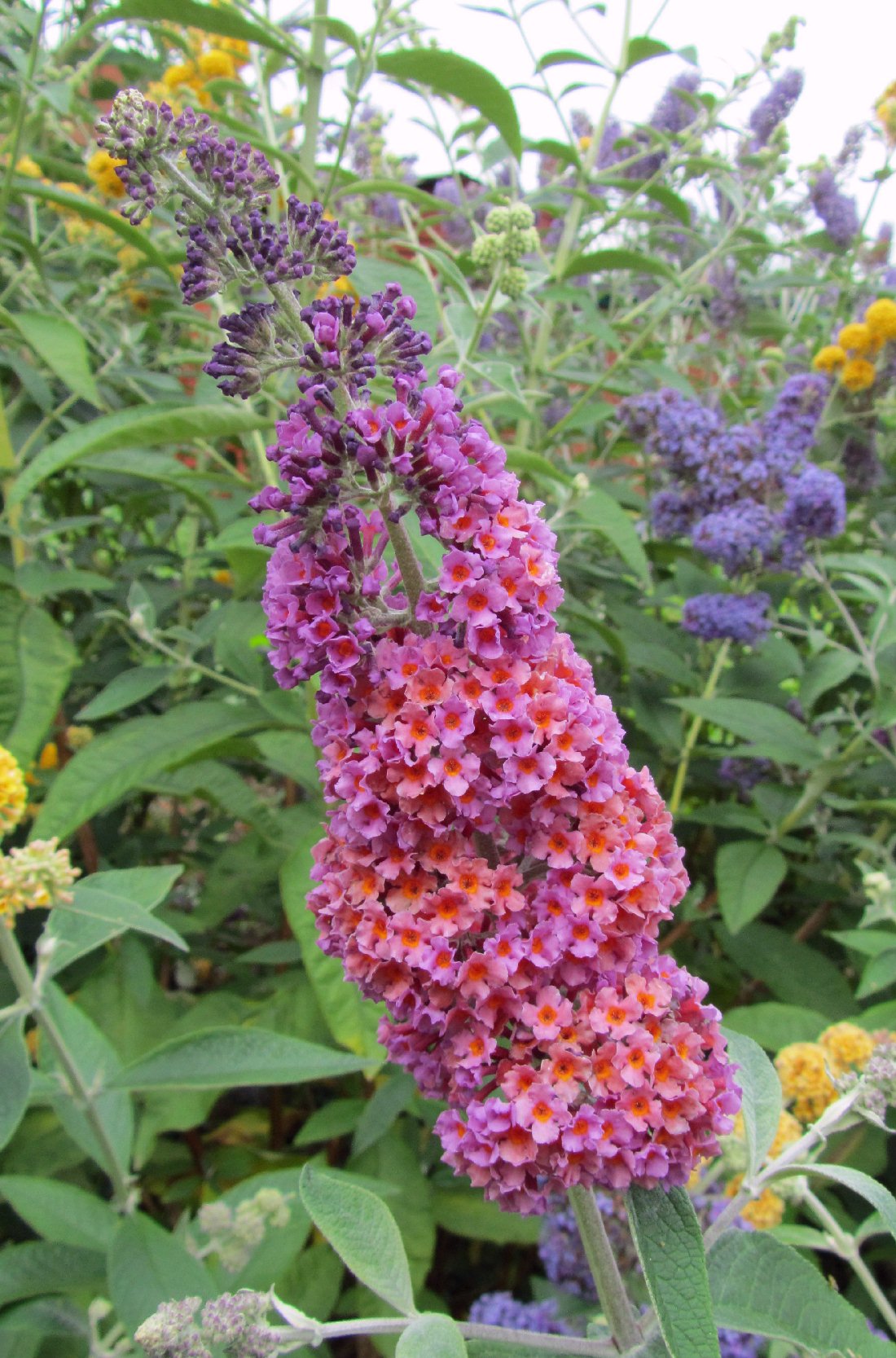
Blue Boy
Raised by Peter Moore of the Longstock Nursery, 'Blue Boy' is a cultivar on a large scale. Big leaves, vigorous tall and wide habit and showy flowers. The flower colour is a light-mid blue and the eye noticeably redder than average. Like many of these plants, it has proved seed sterile, even in the presence of a large number of various potential pollinators.
Open full size image in a new window.
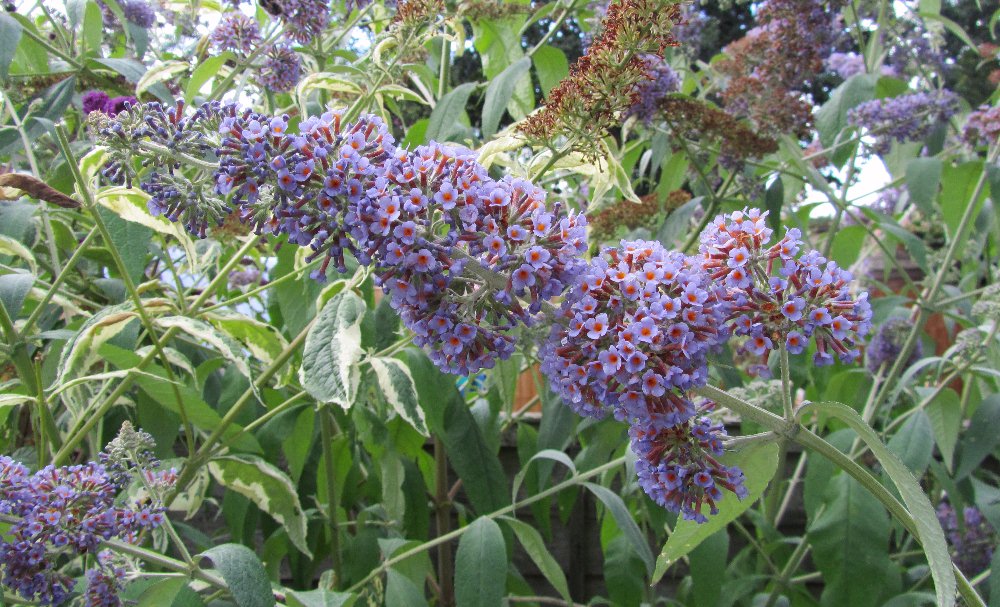
Flutterby Grande™ Peach Cobbler
One of the Flutterby series by Peter Podaras (Podaras#5) in the USA, from a crossing of 'Sungold' X 'Pink Delight'. Not available in Europe, but I managed to blag a plant somehow. Very similar to 'Pink Pagoda' below, with large pink blooms. It has remained quite compact, staying about 2 metres in height.
Open full size image in a new window.
Two other Flutterby Grande cultivars are also from B. x weyeriana:
Flutterby Grande™ Blueberry Cobbler (Podaras#4)
Buddleja weyeriana `Honeycomb` crossed with an unnamed selection of Buddleja marrubiifolia x (Buddleja davidii x Buddleja crispa);
Flutterby Grande™ Vanilla (Podaras#1)
Buddleja weyeriana `Honeycomb` crossed with an un-named Buddleja davidii.
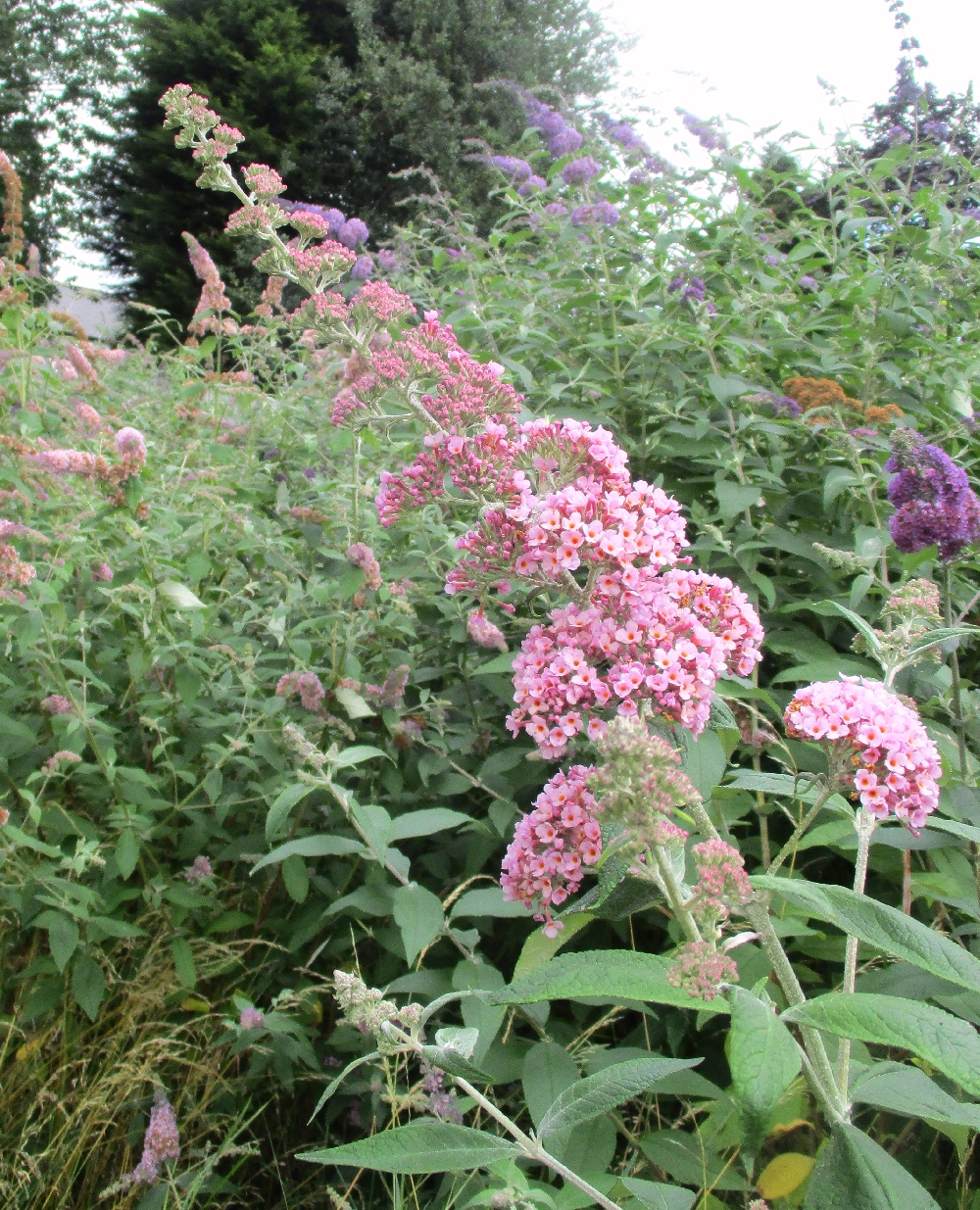
Pink Pagoda
By Peter Moore, and sold in the USA as 'Inspired ® Pink'. It is also a from the cross 'Sungold' X 'Pink Delight'. Large true pink inflorescences with bunches that form levels on the panicle, like a pagoda.
'Pink Pagoda' and 'Peach Cobbler' appear almost the same, but I would say 'Pink Pagoda' is marginally more vigorous and robust. They share the same shade of pink, and 'Peach Cobbler' is not particularly peachy.
Neither produces viable seeds.
Open full size image in a new window.

Pink Sundae
One of my own plants. Very pale pink flowers emerge from lilac buds, which gradually turn to cream. Rather like the effect of 'Moonlight' except the panicle is the same shape as B. davidii. Completely seed sterile.
Open full size image in a new window.
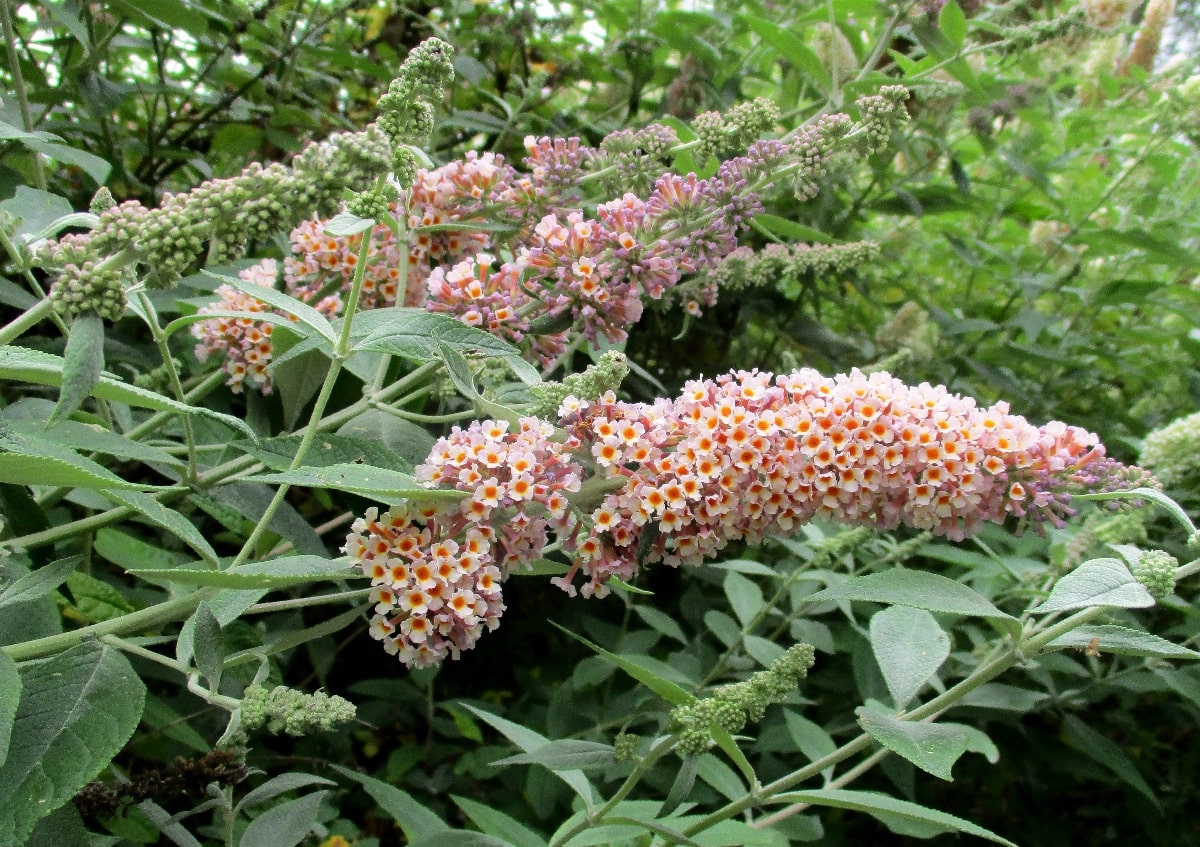
Email:
buddlejagarden@gmail.com
© The Buddleja Garden 2011-2024.
